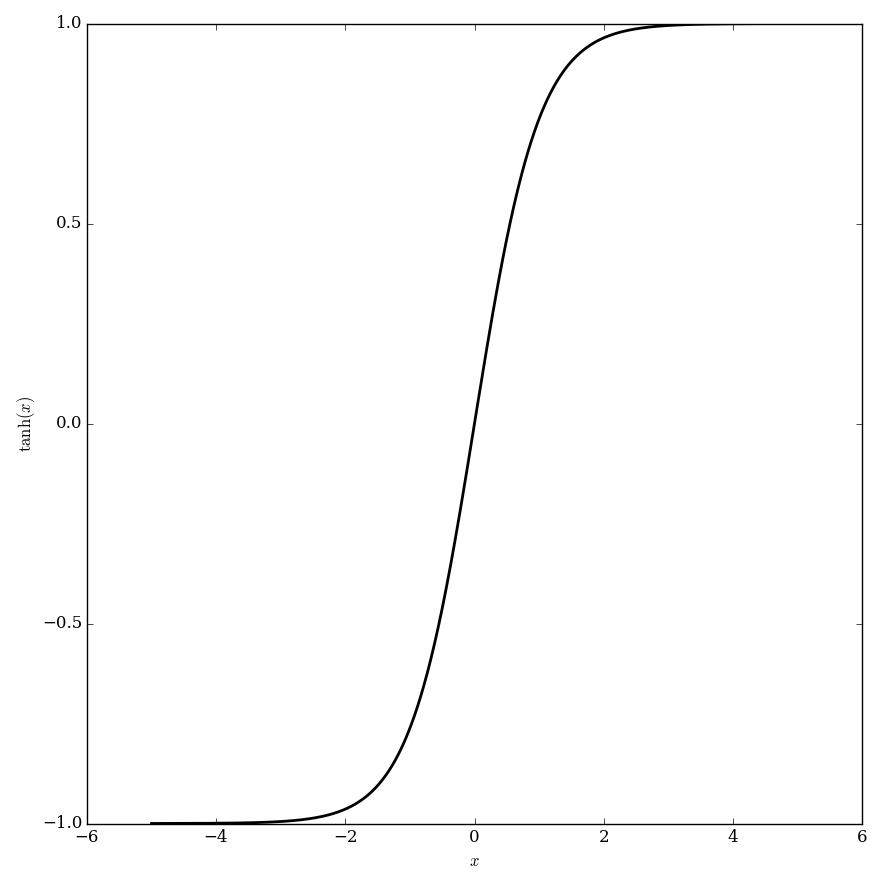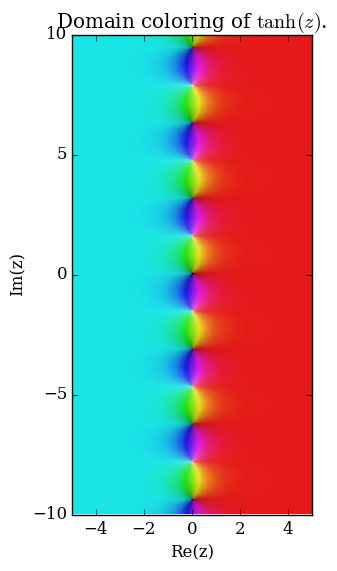Difference between revisions of "Tanh"
| Line 1: | Line 1: | ||
| + | __NOTOC__ | ||
The hyperbolic tangent is defined by the formula | The hyperbolic tangent is defined by the formula | ||
$$\mathrm{tanh}(z)=\dfrac{\mathrm{sinh}(z)}{\mathrm{cosh}(z)},$$ | $$\mathrm{tanh}(z)=\dfrac{\mathrm{sinh}(z)}{\mathrm{cosh}(z)},$$ | ||
Revision as of 07:50, 8 June 2016
The hyperbolic tangent is defined by the formula $$\mathrm{tanh}(z)=\dfrac{\mathrm{sinh}(z)}{\mathrm{cosh}(z)},$$ where $\mathrm{sinh}$ is the hyperbolic sine and $\mathrm{cosh}$ is the hyperbolic cosine.
Domain coloring of $\tanh$.
Properties
Theorem
The following formula holds: $$\dfrac{\mathrm{d}}{\mathrm{d}z} \tanh(z)=\mathrm{sech}^2(z),$$ where $\tanh$ denotes the hyperbolic tangent and $\mathrm{sech}$ denotes the hyperbolic secant.
Proof
From the definition, $$\tanh(z) = \dfrac{\sinh(z)}{\cosh(z)},$$ and so using the derivative of sinh, the derivative of cosh, the quotient rule, the Pythagorean identity for sinh and cosh, and the definition of the hyperbolic secant, $$\begin{array}{ll} \dfrac{\mathrm{d}}{\mathrm{d}z} \tanh(z) &= \dfrac{\mathrm{d}}{\mathrm{d}z}\left[ \dfrac{\sinh(z)}{\cosh(z)} \right] \\ &= \dfrac{\cosh^2(z)-\sinh^2(z)}{\cosh^2(z)} \\ &= \dfrac{1}{\cosh^2(z)} \\ &= \mathrm{sech}^2(z), \end{array}$$ as was to be shown. █
References
Theorem
The following formula holds: $$\displaystyle\int \tanh(z)\mathrm{d}z = \log(\cosh(z))+C,$$ where $\tanh$ denotes the hyperbolic tangent, $\log$ denotes the logarithm, and $\cosh$ denotes the hyperbolic cosine.
Proof
By definition, $$\mathrm{tanh}(z) = \dfrac{\mathrm{sinh}(z)}{\mathrm{cosh}(z)}.$$ Let $u=\mathrm{cosh}(z)$ and use the derivative of cosh, u-substitution, and the definition of the logarithm to derive $$\begin{array}{ll} \displaystyle\int \mathrm{tanh}(z) \mathrm{d}z &= \displaystyle\int \dfrac{1}{u} \mathrm{d} u \\ &= \log \left( \mathrm{cosh}(z) \right) + C, \end{array}$$ as was to be shown. █
References
Theorem
The following formula holds: $$\tanh(z)=-i \tan(iz),$$ where $\tanh$ is the hyperbolic tangent and $\tan$ is the tangent.
Proof
References
- 1964: Milton Abramowitz and Irene A. Stegun: Handbook of mathematical functions ... (previous) ... (next): $4.5.9$
Theorem
The following formula holds: $$\tan(z)=-i\tanh(iz),$$ where $\tan$ is the tangent and $\tanh$ is the hyperbolic tangent.
Proof
References
Theorem
The following formula holds: $$\sin(\mathrm{gd}(x))=\tanh(x),$$ where $\sin$ denotes the sine, $\mathrm{gd}$ denotes the Gudermannian, and $\tanh$ denotes the hyperbolic tangent.
Proof
References
Theorem
The following formula holds: $$\mathrm{tanh}(\mathrm{gd}^{-1}(x))=\sin(x),$$ where $\mathrm{tanh}$ denotes the hyperbolic tangent, $\mathrm{gd}^{-1}$ denotes the inverse Gudermannian, and $\sin$ denotes sine.
Proof
References
Theorem
The following formula holds: $$\dfrac{\mathrm{gd}(x)}{2} = \displaystyle\sum_{k=0}^{\infty} \dfrac{(-1)^k \mathrm{tanh}^{2k+1}(\frac{x}{2})}{2k+1},$$ where $\mathrm{gd}$ is the Gudermannian and $\tanh$ is the hyperbolic tangent.

